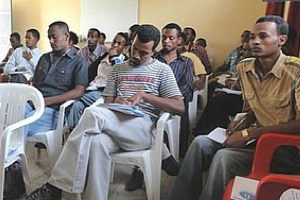Difference between revisions of "Direct support to service providers"
(→Acknowledgements) |
(→Selected references, tools and templates) |
||
| Line 37: | Line 37: | ||
===Selected references, tools and templates=== | ===Selected references, tools and templates=== | ||
| − | * Direct support to rural water service providers [ | + | * Direct support to rural water service providers [https://www.ircwash.org/news/direct-support-rural-water-service-providers building block summary sheet] |
===Field experiences=== | ===Field experiences=== | ||
Revision as of 03:02, 19 May 2020
support costs for water
This is a structured system of direct (post-construction) support provided to back up and monitor community management entities and other service providers.
Direct support often includes:
- Performance monitoring
- Technical advice and information
- Administrative support (e.g. help with tariff setting)
- Organisational support (e.g. to achieve legal status) and conflict resolution
- Identifying capital maintenance needs (including advice on financing)
- Training and refresher courses
Why is it important for sustainable services at scale?
Community-based service providers often need regular, structured support to help them fulfill administration, operation, asset management and maintenance functions. This has been shown to improve the likely sustainability of water services and to help reduce major breakdowns and faults.
Costs and financing
The costs of providing support are included as part of overall recurrent expenditure (Expenditure on Direct Support(ExpDS).
Recent research findings from a range of countries indicate expenditure of between US$ 2 - US$ 3 per person per year on direct support results in reasonable levels of functionality.
Such expenditure levels appear to be the minimum required to fund these kinds of support interventions.
The same research found that in a number of African countries where less than US$1per person per year is spent on direct support, it is unlikely that such interventions are sufficient to make a significant improvement in service levels.
Recommendations
Obtain a clear mandate for support: an essential first step for providing direct support is to identify who should undertake this role and the limits of their mandate with respect to service providers.
Provide sufficient (financial) resources:having identified who is going to provide what sort of support, it is essential to ensure sufficient resources for them to fulfill their mandate. This starts with the human and material capacity, but ultimately requires adequate and reliable annual budgeting;
Identify financial sources:the source of financing is a question that has to be answered at a country level. Governments may need to provide the bulk of the costs of direct support as tariffs rarely are high enough to meet these kind of expenditures.
Ensure cost-effectiveness:support mechanisms to improve cost-effectiveness, for example through experimentation with different institutional arrangements, area based support contracts, use of benchmarking and involvement of the private sector.
Selected references, tools and templates
- Direct support to rural water service providers building block summary sheet
Field experiences
 Dutch WASH Alliance in Hararghe & Dire Dawa |
 Integrated WASH project for Acholi Sub region |
Other links
Acknowledgements
- Support to service providers. Water Services That Last. IRC.
